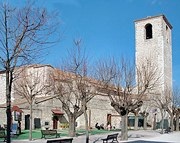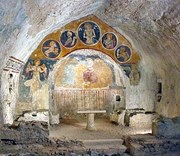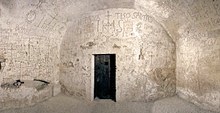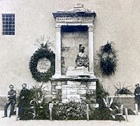


Visits to this complex are arranged by Narni Sotterranea and start on the site of the convent of San Domenico. This complex was used by Napoleon's soldiers in the early 19th century, finally abandoned by the friars in 1860, largely destroyed in the bombing of the Second World War and subsequently demolished. The rubble from this demolition covered the entrance to an underground complex until 1979, when a group of young cavers re-discovered it. They began the painstaking work of removing the debris that filled the rooms, and the complex was finally opened to the public in 1994.
Sant' Angelo (12th century)

This church was used as a wine cellar by Napoleon's soldiers because of its perfect microclimate. All records of it were then lost, and the rediscovery of 1979 was thus a complete surprise. The church was re-consecrated in 2000 as Santa Maria della Rupe, so-named because it had been built into the chalk cliff on which Narni stands. However, a 15th century manuscript re-discovered two years later revealed that it had originally been dedicated to St Michael Archangel, and it is now known as Sant' Angelo.
The church, which is in the form of a single barrel-vaulted nave with a semi-circular apse, has superb acoustics. Its Cistercian architecture suggests that it probably belonged to the monastery of San Bernardo (dedicated to the Cistercian St Bernard of Clarvaux), which stood in the adjacent Giordano di San Bernardo until it was demolished in the 19th century.
Frescoes
The presbytery arch is decorated with frescoes (12th century) in tondi of the Pietà and symbols of the Evangelists . Two frescoes (12th century) of St Michael (the titular of the church) stand to the sides:
-
✴St Michael killing the dragon (to the left); and
-
✴St Michael weighing the souls of the dead (to the right).
The fresco (13th century) in the apse depicts the Coronation of the Virgin.
The barrel vault of the nave is frescoed as a starry sky. The relief at the centre is of the lamb of God, with the sun and the moon representing alpha and omega.
The damaged frescoes on the left wall include a figure of the Madonna and Child, along with Dominican saints that were added after the Dominicans acquired the site in 1303.
Roman Domus
The visit then continues to a large room that contains a circular cistern and traces of a pavement that probably belonged to a Roman domus (house). The room now contains copies of tools that Roman surveyors used to build the Acquedotto della Formina (24 - 33 AD). The plaques on the walls describe this impressive piece of engineering, along with other hydraulic works in Narni from the Roman period - see the page on Ponte Cardona.
Rooms of the Inquisition

A long passage continues to another room under the apse of San Domenico that the Inquisition used in the 18th century. [A trapdoor in the roof provided access to the apse of the church.] This room now houses an exhibition of photographs of the instruments of torture that were found here.
The graffiti in a small cell that adjoins this room attests to the prisoners' suffering, although the precise meaning of many of the symbols is unclear:
-
✴a number of numerical sequences probably record the periods that various prisoners spent here (ie. ORA 720 1759 probably refers to 720 hours or 30 days in 1759);
-
✴the repeated motif of the sun might be associated with what seems to be a sketch of a sundial [on the right]; and
-
✴the repeated monogram IHS with a Cross above and the date 1759 below probably alludes to the Dominicans' persecution of the Jesuits at this time.
In most of the inscriptions in the cell, the letter "T" is used instead of "D", presumably because the prisoners hated the Dominicans. Thus, the inscription "IL PARATISO SANTO", high up on the entrance wall, refers to the heavenly paradise. The most complex iconography seems to be associated with the inscription "IO GIUSEPPE ANTREA LOBARTINI ... CARGERATO". Lombardini was a Jesuit who was incarcerated here in 1759.
On the right of the entrance (looking from inside the cell), there is a sketch of a tree to which doves, each of which bears an olive branch, are tied. Below, a falconer hunts the doves, almost certainly an allusion to the Dominicans' persecution of the Jesuits.
Not all of the prisoners were Jesuits:
-
✴A document of 1726 (which is exhibited in the room above) records that Domenico Ciabocchi was imprisoned here for bigamy, but escaped after strangling the friar who brought his lunch.
-
✴Three inscriptions to the left of the entrance record Pasqualucci Andrea, a prisoner here in 1811 when Napoleon's soldiers used the complex as a barracks.
Two columns from these rooms were used in the monument to Giordano Bruno, which was erected in Piazza Cavour (see Walk I) in 1910. The symbolism was poignant: the Dominican Giordano Bruno had been executed as a heretic in 1600 and a statue of him had been erected in Rome in 1860, in the anti-clerical atmosphere following the unification of Italy. The monument in Narni was erected fifty years later, defiantly overlooking the Duomo. The monument was removed in 1926 on the orders of the Fascist government. The columns were destroyed at this point, but the bust of Giordano Bruno by Salvatore Buemi was moved to the atrium of Palazzo Comunale. It was relocated [where??] in February 2010.
The tour finishes in a room above the cell that contains photographs of instruments of torture.
Monument to Giordano Bruno

A statue of him had been erected in Rome in 1860, in the anti-clerical atmosphere following the unification of Italy. The monument in Narni, which was erected fifty years later , was removed in 1926 on the orders of the Fascist government. The columns were destroyed at that time, but the bust of Giordano Bruno by Salvatore Buemi was moved to the atrium of Palazzo Comunale (see below). It was relocated [where??] in February 2010.
For opening hours, see the website of the Provincia di Terni.
Return to Monuments of Narni.
Return to Walk I.

